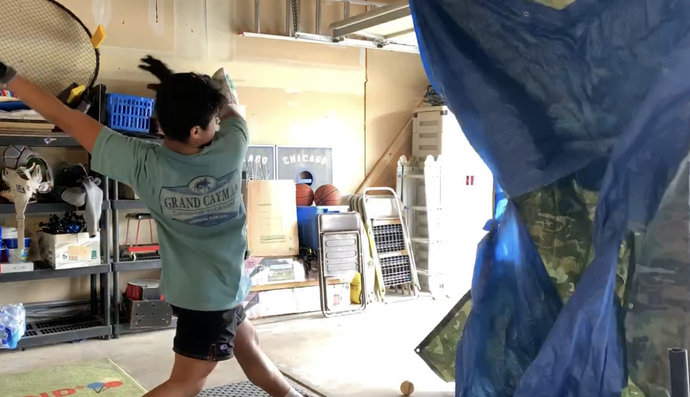Recruitment and The Coronavirus: How The Pandemic is Impacting Athletes
Marco Torres, senior, does batting practice in his garage.
August 24, 2020
Due to COVID-19, the recruitment process for high school athletes has brought many new obstacles to navigate as recruitment goes digital, sports seasons change, and uncertainty arises over the available roster and scholarship opportunities.
While under quarantine, various sports organizations banned athletes and college coaches from interacting in person, pushing athletes to take the reins in order to create a relationship with the coaches digitally.
“Instead of coaches contacting them, girls were having to push their videos out and email coaches and say, ‘Hey, I’m really interested in going to your school. Here is a video of me to watch and let me know what you think.’ I feel like girls have had to be more proactive in the recruiting process,” said head girls volleyball coach Lindsey Hawkins.
High school athletes have also had to become more creative to display their skills to schools digitally.
St. Charles North head football coach Robert Pomazak said, “We made a combine day where we filmed all of our players going through basically all of the different drills of an NFL combine, and from there we’re making individual evaluation recruiting tapes for them.”
Digital recruitment has come with many challenges for college coaches and athletes because not every component coaches that look for in a player can be translated over Zoom or on highlight videos.
“[Digital recruitment] makes it very difficult to be noticed as a player since the coaches cannot see the other intangibles like hustle, body type, accuracy, speed, baseball IQ, and overall physical appearance,” said head baseball coach Todd Genke.
However, new methods are being discussed to allow for coaches to watch potential recruits play live and see how they perform in a game setting.
“Now what tournaments are talking about doing, to limit the number of people in the gym at any given time, is they are thinking about streaming those tournaments so college coaches could just watch,” said Hawkins.
Pomazak also said that the most important thing for the football players was to try and reach out to coaches through Twitter, direct messaging, phone calls, and to get their latest “films” out there. When asked if he thought this way of recruiting people would stay, he said that the ability to physically see players was a much more valuable and telling resource than the videos could ever be.
Last March, sports seasons were canceled due to COVID-19, and as a result, high school athletes weren’t able to take advantage of recruitment opportunities that came with the spring season.
“For a lot of girls who were juniors last year, they missed out on the time to be recruited because we shut down in March and a big-time for club volleyball is March, April, and then June we have nationals and that whole time period is when college coaches are out coming to watch because they are also not in season, so it’s like perfect timing,” said Hawkins.
There is a lot of uncertainty around recruitment right now, especially when it comes to the available roster and scholarship opportunities.
“[National Collegiate Athletic Association] granting another year of eligibility for the college seniors that were not able to play this past spring. Since that decision adversely affects the roster size and scholarships awarded, many schools across the country did not recruit like they normally would have. As a result, these changes will negatively affect many players over the next 5-10 years and even beyond,” said Genke.
Colleges allowing their seniors to play another season creates new challenges for those in the class of 2021 looking to be recruited.
“It hurts us because there’s gonna be less roster spots for us to take in next year. So, a lot of schools aren’t really taking in a lot of recruits next year since a lot of their seniors are staying,” said baseball player Marco Torres, senior.
While the pandemic has created a lot of uncertainty and challenges for athletes, it has also allowed for more time to focus on training.
“[Quarantine] helped me a lot to focus on other skills over the last five months we’ve been in quarantine. So, I’ve actually gotten a lot better since quarantine,” said Torres.
Due to COVID-19, recruitment has changed drastically and challenged athletes to be very proactive in the process.
“It’s really just about networking and trying to get the most current film of the players out as quickly as possible and to the right people,” said Pomazak.



